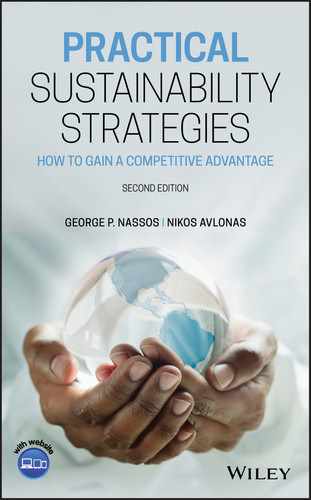CHAPTER 17
Sustainable Strategies and Beyond
There are many opportunities to implement sustainable strategies and reduce the impact on the environment, provide social benefits, and do it profitably. It is a matter of thinking on how to make a service or product more sustainable, or even develop a new product or service for an unmet need.
While teaching a course titled “Business Strategy: The Sustainable Enterprise” for over 12 years and another course on “Sustainability Management” for the past two years, the final project for each student was to take a strategic business unit (SBU) at their place of employment and propose how to make it sustainable. The proposal must show how the new business model would possess environmental integrity, social equity, and economic viability. For those students that were not employed, they had the option to propose a project for a publicly held company or to propose a new business. Some of the proposed projects were the following:
- Medication delivery—Proposing the reuse of bottles and tubing rather than disposal after one use.
- Farm equipment—A central logistics service providing tractor, huskers, and others to farms in a region rather than every farmer required to possess each piece.
- Eco-toys—Lease toys to families as they are used for a period of time considerably less than the life of the toy.
- Endless Christmas—Since both buying a plastic artificial tree from China and cutting down a real tree for two-weeks use are not good for the environment, why not lease a tree for the holidays; and allow someone else to lease it the following year.
- Ford Base of the Pyramid (BOP)—Proposed a joint venture between Ford and Infosys, a company in India, to produce a low cost car employing the BOP strategy.
- Communal refrigeration—Large refrigeration and freezers to be shared by people living in small apartments in a large building.
- Highway solar panels—Install solar panels along or on highways where land is not used.
- Home furnishings—Expensive long lasting home furnishings can be exchanged for a different long lasting style.
- eClub—For those that want the latest electronic equipment, lease it and then allow someone who doesn't need the latest to buy it.
- Moo-trient—Collect cattle methane waste and convert it energy and cattle manure to fertilizer.
- Horizontal refrigeration—Migration of users to a horizontal orientation for refrigeration with present level of technology used by the chest freezers: thicker insulation and larger cooling plate.
- Reuse furniture scraps—Collect the textile and leather remnants, primarily from high end and luxurious furniture companies, and manufacture new smaller products like pillows, wallets, hats, gloves, handbags, and jewelry.
- Home delivered meals—Deliver the dinner that will come along with reusable and compostable options giving the customers the option to return the reusable containers or the compostable containers.
- Refrigeration for sub-Saharan Africa—A company will provide on-demand transportation services connecting the farmers with refrigeration facilities.
- Eco-travel—Provide tourism options that are all sustainable in order to reduce environmental issues at highly visited locations such as the Phi Phi Islands in Thailand, or pollution and erosion in Machu Picchu (Peru) due to massive tourism, and the ecological deterioration of Mount Everest.
- Ice cream shop—Collecting the plastic wrap and wooden sticks, after popsicles are consumed, to recycle.
Once the concept of sustainability is embraced, it will become automatic to think of ways to make a product or service more sustainable. Just thinking about everyday products and services, one might think of the following:
- A pizza container may be used for only five minutes, the time it takes from the restaurant to your home. Then it may not be recyclable if it is greasy or even if it is recyclable, the process is costly for a product used for only five minutes. Why not provide returnable pizza containers?
- Most hotel rooms provide small bottles of shampoo, conditioner, and/or skin lotion. Each may be partially used and then disposed or sent to a community center. Why not provide a large refillable container in the bathroom so the occupant uses only what is needed and provides no waste.
- When flossing teeth, a piece of floss about 12 in. long is needed for wrapping around the fingers. However, only 0.5 in. of the floss is actually performing the work of cleaning the teeth. The other 11½ in. is actually waste. Why not provide a device containing the floss so that only a small piece is used and then advanced on the tool to expose a clean section.
Many more ideas can be developed as people accept sustainable strategies and the need for them becomes more critical. So start thinking.
